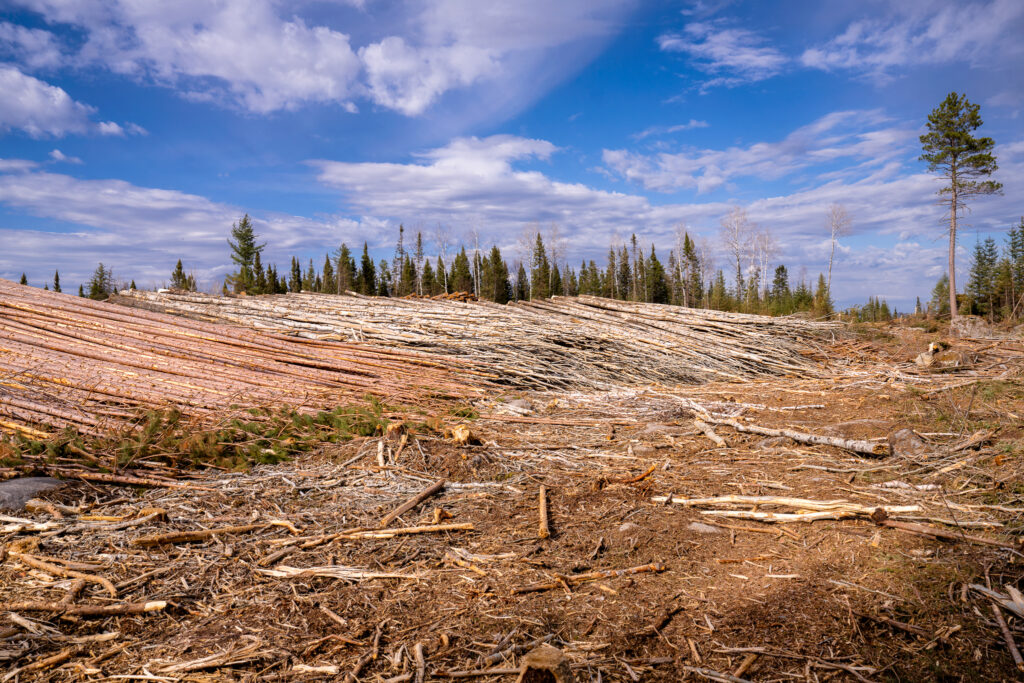Logging in northeast Minnesota. Photo by Chad Davis for Minnesota Reformer.
Senior managers at both the Minnesota Department of Natural Resources and the U.S. Fish and Wildlife Service should be held to account for allowing the misuse of federal grants to facilitate logging in Minnesota’s wildlife management areas and aquatic management areas.
Both agencies cooperated to fund and allow aggressive logging, which has devalued habitat and undermined the legitimacy of federal grants.
It seems the only accountability that will work is to step outside the respective agencies’ control systems and go public, while relying on the Office of Legislative Auditor to do its work. The OLA recently announced a special review of DNR’s oversight of wildlife management areas.
The issue began in 2018 when the DNR completed what’s called a sustainable timber harvest analysis and adopted the subsequent Sustainable Timber Harvest Initiative.
The analysis said the following: “Maintaining current harvest levels, or increasing above current harvest levels, will impact the agency’s ability to move the forest toward goals for biodiversity and habitat for both young and old forest-dependent wildlife.”
But in the face of this analysis, the initiative increased timber harvest on state lands. It relied heavily on computer-generated models, thus removing most local staff planning and the flexibility of how many forest stands to harvest. This affected wildlife management areas because these areas are to be managed for habitat — not timber production based on economical harvest ages. Timber management for wildlife should ensure a balance of younger, mature and over mature aged forests in each management area for deer, bears, birds and a host of other wildlife.
Many wildlife management areas were acquired using federal Pittman-Robertson grant funding via a 75% cost share. And all WMAs are managed, at least in part, using that same funding. There is a federal nexus from this cost share: The areas are to be used for the purpose for which they were acquired, and the DNR commissioner must assent to the Pittman-Robertson Act.
In 2019, 28 WMA managers and staff wrote a memo to the commissioner stating their concerns about the Sustainable Timber Harvest Initiative. .
The DNR viewed this communication as being insubordinate, and nothing changed.
The grant funding and logging activity continued. The agencies used a provision of the National Environmental Policy Act called a “categorical exclusion” to remove the logging from the scrutiny of an environmental analysis, despite the protestations of front line natural resource workers. NEPA requires an environmental assessment when controversy is present and, per federal regulations, the DNR (the grantee) is responsible. But the U.S. Fish and Wildlife did not require an environmental assessment for distribution of federal grant funds in this case. Even though logging occurred in wolf, lynx and bat habitat.
In 2020, U.S. Fish and Wildlife performed a field review/site inspection of some wildlife management areas. The agency did not release their report — and continued to provide grant funding. The DNR continued to award logging contracts.
The report — acquired by Public Employees for Environmental Responsibility, or PEER, in 2023 — found the DNR claimed approximately $1.4 million in program income from timber sales under the Pittman-Robertson grant. But selling timber without regard to habitat disregards the spirit of the law, and pretending that doing so reduces the cost of the grant to taxpayers is misleading, at best.
In 2022, the controversy became quite public. PEER wrote a letter to the director of the Fish and Wildlife Service and published it on their website — natural resource professionals publicly stepping outside the agency to seek compliance. The FWS began to meet with the DNR in an effort to diminish the logging and require environmental documentation.
And in 2023, the FWS began to withhold some grant funds, which were later restored. But there remains an impasse on the timber harvest question on wildlife management areas, especially as to how cumulative harvests meet the relevant law — the National Environmental Policy Act — as there has never been an environmental review done for this activity in wildlife management areas. .
Setting aside all the bureacratic jargon and back-and-forth: People who know the delicate ecology of these areas are sounding the alarm about logging and its impact on wildlife.
Public pressure has made a difference in encouraging the federal government to hold DNR’s feet to the fire. But there still hasn’t been any substantive changes in policy, even though the DNR commissioner cannot override federal law.
The best and simplest solution is to stop treating wildlife management areas like conventional state forest — we need a timber harvest system for WMAs that considers the best interest of the critters, and not just profit-seeking timber companies.
We hope the Office of Legislative Auditor comes to the same conclusion.
The post State and federal officials are endangering wildlife, misusing federal grants for logging appeared first on Minnesota Reformer.
